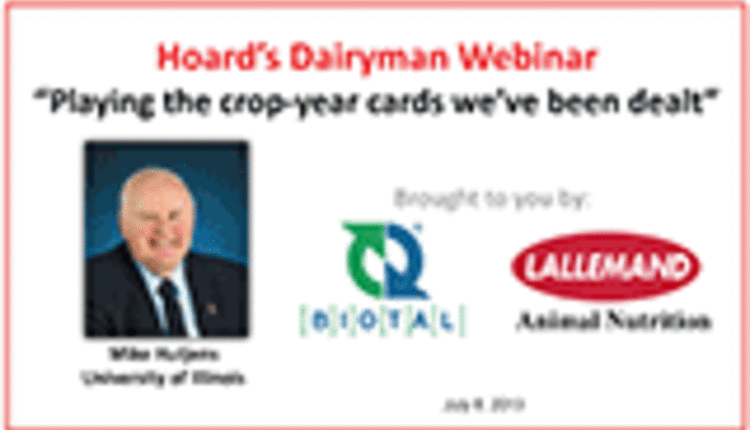 Mike Hutjens, University of Illinois, presented "Playing the crop-year cards we've been dealt" webinar on Monday, July 8.
Mike Hutjens, University of Illinois, presented "Playing the crop-year cards we've been dealt" webinar on Monday, July 8.Labeled the "perfect storm" by Mike Rankin, Wis., the country's weather conditions have created some unique challenges to crop production. More than 1 million acres in Wisconsin and an additional 750,000 acres in Minnesota, South Dakota and Iowa experienced alfalfa winterkill last year. The drought was widespread last year and a cool, wet spring in 2013 added to the mix. These conditions left forage shortfalls and little or no carryover of corn silage for 2013. Most recommend 4 to 6 months of corn silage carryover in a normal year. However, Hutjens warns dairy producers not to feed forages that are too old, as they can be lethal.
The first cutting alfalfa was delayed by 2 to 4 weeks in the Midwest. Forage quality has also suffered, netting less starch and more fiber. Corn planting also was delayed, and, unfortunately, fields flooded and some were replanted due to 16 to 20 inches of rainfall above normal in parts of Wisconsin. On the other side of the country, California was short 20 inches of annual rain. Cottonseed prices rose about $50 per ton due to drought in those areas as well. So, a number of factors continue to wreak havoc on crop production and purchasing decisions for dairies across the country.
With those weather conditions, what to do in July?
• Corn silage will be high biomass, and not a lot of starch.
• Sorghum/Sudan grass loves hot weather, moisture and manure
• Buy standing forage
As August approaches, there are a few options.
• Plant corn for silage
• Plant late summer alfalfa
• Plant cereal grains (oats)
• Buy standing forage
• Buy straw
In September, options include:
• Winter cereal (triticale, wheat)
• Harvest corn stalks
• Buy straw
• Buy standing forages
When planning feed inventory, estimate 7 tons of corn silage dry matter for each cow per year. "Corn silage needs to behave as a forage," remarked Hutjens. Processors need to pay attention to kernel processing scores. Poorly processed corn silage can cost you 2 pounds per cow, while correctly processed will give you an additional 2 pounds of milk production. A shaker box and ruler will give you the numbers to help you evaluate particle length.
However, if you are short of feed, you have a few strategies to follow to make up for corn silage shortfalls. If you will be short, you might try:
• Buying alfalfa
• Growing more corn silage
• Depending on greater use of by-products
•Consider corn stalks or straw
• Feed more grain
"There's no sense not saving everything you've got in the field. You've just got to use inoculants, period!" Hutjens announced. You'll see a 3 percent spike in dry matter recovery and a 2 percent rise in digestibility. At a cost of about $1 per ton, you gain 5 to 6 percent in feed quality and volume. A 3 percent savings can be realized when an oxygen barrier covering is used because it reduces dry matter loss by 50 percent in the top 1.5 to 3 feet of the pile. That's an 8:1 return on investment when feeding high producing cows.
As mentioned in previous webinars, Hutjens noted that regional prices really are pivotal points, and he suggested using free software tools like FeedVal 2012, where you enter feed prices for the area. This gives each producer their own breakeven points. It also is a good idea to evaluate feed inventories to see if current/projected feed supplies are adequate. And, if inventories will run short, plan now while you still can.
Biotal Forage Inoculants sponsored the July webinar. Learn more about this Lallemand Animal Nutrition product, visit www.qualitysilage.com.
The July webinar is archived and available for viewing.

The author is the online media manager and is responsible for the website, webinars and social media. A graduate of Modesto Junior College and Fresno State, she was raised on a California dairy and frequently blogs on youth programs and consumer issues.









